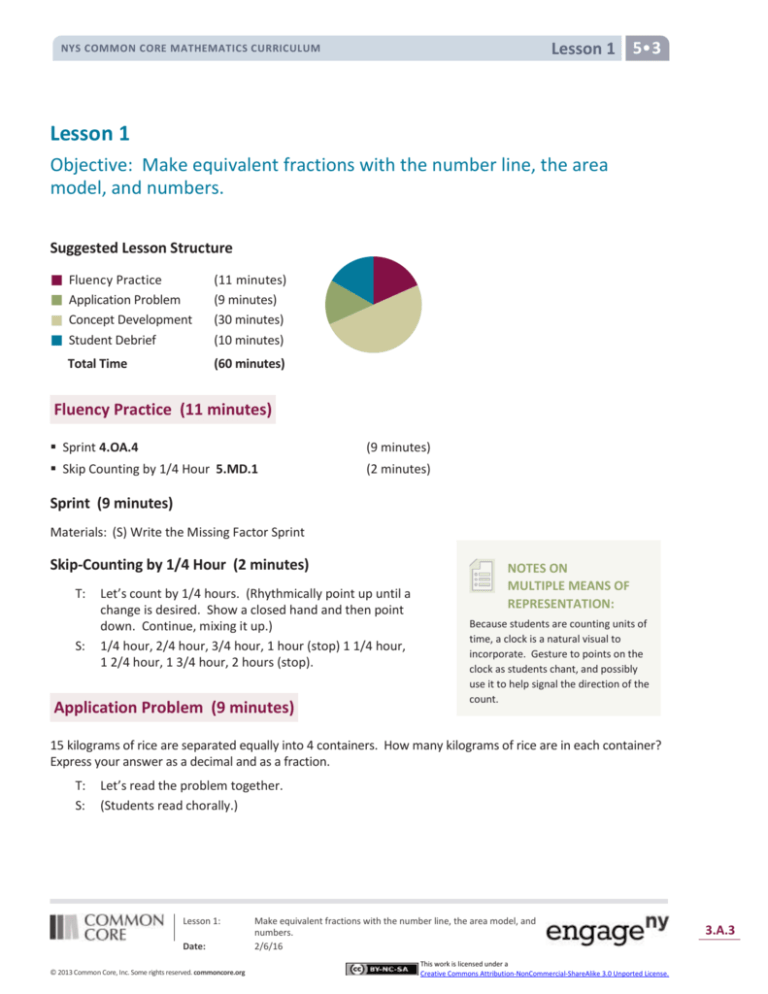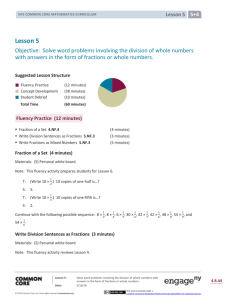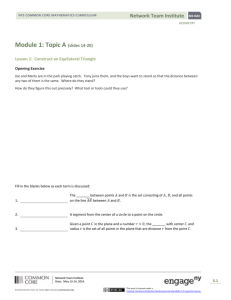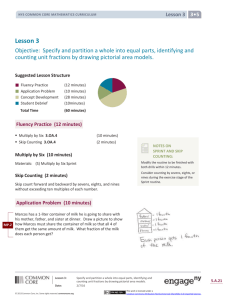
Lesson 1 5•3
5•3
NYS COMMON CORE MATHEMATICS CURRICULUM
Lesson 1
Objective: Make equivalent fractions with the number line, the area
model, and numbers.
Suggested Lesson Structure
Fluency Practice
Application Problem
Concept Development
Student Debrief
Total Time
(11 minutes)
(9 minutes)
(30 minutes)
(10 minutes)
(60 minutes)
Fluency Practice (11 minutes)
Sprint 4.OA.4
(9 minutes)
Skip Counting by 1/4 Hour 5.MD.1
(2 minutes)
Sprint (9 minutes)
Materials: (S) Write the Missing Factor Sprint
Skip-Counting by 1/4 Hour (2 minutes)
T:
S:
Let’s count by 1/4 hours. (Rhythmically point up until a
change is desired. Show a closed hand and then point
down. Continue, mixing it up.)
1/4 hour, 2/4 hour, 3/4 hour, 1 hour (stop) 1 1/4 hour,
1 2/4 hour, 1 3/4 hour, 2 hours (stop).
Application Problem (9 minutes)
NOTES ON
MULTIPLE MEANS OF
REPRESENTATION:
Because students are counting units of
time, a clock is a natural visual to
incorporate. Gesture to points on the
clock as students chant, and possibly
use it to help signal the direction of the
count.
15 kilograms of rice are separated equally into 4 containers. How many kilograms of rice are in each container?
Express your answer as a decimal and as a fraction.
T:
S:
Let’s read the problem together.
(Students read chorally.)
Lesson 1:
Date:
© 2013 Common Core, Inc. Some rights reserved. commoncore.org
Make equivalent fractions with the number line, the area model, and
numbers.
2/6/16
This work is licensed under a
Creative Commons Attribution-NonCommercial-ShareAlike 3.0 Unported License.
3.A.3
Lesson 1 5•3
5•3
NYS COMMON CORE MATHEMATICS CURRICULUM
T:
T:
T:
Share with your partner: What do you see when you
hear the story? What can you draw?
(Students share with partners.)
I’ll give you one minute to draw.
Explain to your partner what your drawing shows.
(After a brief exchange.) What’s the total weight of the
rice?
15 kilograms.
15 kilograms are being split equally into how many
containers?
4 containers.
So the whole is being split into how many units?
4 units.
To find 1 container or 1 unit, we have to?
Divide.
Tell me the division sentence.
15 ÷ 4.
Solve the problem on your personal white board. Write
your answer both in decimal form and as a whole
number and a decimal fraction. (Pause.) Show your board.
Turn and explain to your partner how you got the answer. 15 ÷ 4 = 3.75
(After students share.) Show the division equation with both answers.
S:
15 ÷ 4 = 3.75 = 3
T:
S:
T:
Another fraction equivalent to 75 hundredths is?
3 fourths.
Also write your answer as a whole number and a fraction.
S:
15 ÷ 4 = 3.75 = 3 100 = 3. 4.
T:
T:
S:
So 3 and 3 fourths equals 3 and 75 hundredths.
Tell me your statement containing the answer.
Each container holds 3.75 kg or 3 3/4 kg of rice.
S:
T:
T:
T:
S:
T:
S:
T:
S:
T:
S:
T:
S:
T:
75
.
100
75
3
Concept Development (30 minutes)
Materials: (S) 4 Paper strips sized 4 1/4 x 1 per student (vertically cut an 8 ½” x 11” paper down the middle)
Problem 1
T:
Take your paper strip. Hold it horizontally. Fold it vertically down the middle. How many equal
parts do you have in the whole?
Lesson 1:
Date:
© 2013 Common Core, Inc. Some rights reserved. commoncore.org
Make equivalent fractions with the number line, the area model, and
numbers.
2/6/16
This work is licensed under a
Creative Commons Attribution-NonCommercial-ShareAlike 3.0 Unported License.
3.A.4
Lesson 1 5•3
5•3
NYS COMMON CORE MATHEMATICS CURRICULUM
S:
T:
S:
T:
T:
T:
T:
T:
T:
T:
S:
T:
2.
What fraction of the whole is 1 part?
1 half.
Draw a line to show where you folded your paper and
label each half 1/2, one out of 2 units.
As you did in fourth grade, take about 2 minutes to
make paper strips to also show thirds, fourths, and
fifths.
(After about 3 minutes to make the paper strips.)
Draw a number line that is a little longer than your
paper strip. Use your strip as a ruler to
0 1 2
mark zero and 1 above the line, 2 , 2 , 2
below the line.
(After doing so.) Make about an inch by
inch square beneath your line. This is
representing the same 1 whole as the
number line. For today, show half by
vertically dividing the square. Shade 1
half on the left.
(After discussion.) Draw another square
to the right of that one. Shade it in the
same way to represent 1/2.
Partition it horizontally across the
middle.
What fraction is shaded now?
1
2
2
or .
4
(Record numerically referring to the picture) 1 group of
2 out of two groups of 2.
𝟏 𝟏 𝐠𝐫𝐨𝐮𝐩 𝐨𝐟 𝐭𝐰𝐨
𝟏 × 𝟐
𝟐
=
𝐨𝐫
=
𝟐 𝟐 𝐠𝐫𝐨𝐮𝐩 𝐨𝐟 𝐭𝐰𝐨
𝟐 × 𝟐
𝟒
T:
Explain how we have represented the equivalent
fractions to your part.
T:
Show me on the number line. (Students show.) Yes,
4
it is the exact same number as 1 half, the exact same
point on the number line.
Work with your partner to draw another congruent
T:
2
Lesson 1:
Date:
© 2013 Common Core, Inc. Some rights reserved. commoncore.org
NOTES ON
MULTIPLE MEANS OF
ACTION AND
EXPRESSION:
Sentence frames help students
remember the linguistic and numerical
patterns. As they gain confidence, flip
it over so they do not become overly
dependent.
___ group of ___
___ × ___
= ___ group of ___ or ___ × ___ =
.
Make equivalent fractions with the number line, the area model, and
numbers.
2/6/16
This work is licensed under a
Creative Commons Attribution-NonCommercial-ShareAlike 3.0 Unported License.
3.A.5
Lesson 1 5•3
5•3
NYS COMMON CORE MATHEMATICS CURRICULUM
square with 1 half shaded. This time partition it
horizontally into 3 equal units (2 lines) and record the
equivalent fraction as we did on the first example. If
you finish early, continue the pattern.
Problem 2
1
3
Make fractions equal to .
This problem allows students to repeat the procedure with
thirds, another benchmark fraction. As needed for your
students, you might repeat the process thoroughly as outlined
in Problem 1. Work with a small group as others work
independently, or let them try it with a partner. It is not
necessary for all students to complete the same amount of
work. Move on to Problem 3 after about 4 minutes on Problem
2.
NOTES ON
MULTIPLE MEANS OF
ENGAGEMENT:
Because this lesson is so pictorial, it is
perfect for ELLs. Support them making
the connection of the words to the
numbers, the numbers to the pictures,
through the use of your gestures and
hands. “One unit of two” (pause and
point to the image and then to the
numbers).
Note in the drawing to the right that 6 ninths is shown to be
equal to 4 sixths. Go back and make sure this point is clear with
2 sixths, 3 ninths, and 4 twelfths.
Problem 3
2
Make fractions equal to 3.
The next complexity is working with a non-unit fraction.
Problem 4
5
4
Make fractions equal to .
The final complexity prior to working independently is to model
a fraction greater than 1. The same exact process is used.
Rectangles are used in the example just to break rigidity. This is
not unique to squares!
Lesson 1:
Date:
© 2013 Common Core, Inc. Some rights reserved. commoncore.org
Make equivalent fractions with the number line, the area model, and
numbers.
2/6/16
This work is licensed under a
Creative Commons Attribution-NonCommercial-ShareAlike 3.0 Unported License.
3.A.6
Lesson 1 5•3
5•3
NYS COMMON CORE MATHEMATICS CURRICULUM
Problem Set (10 minutes)
Students should do their personal best to complete the
Problem Set within the allotted 10 minutes. Some
problems do not specify a method for solving. This is an
intentional reduction of scaffolding that invokes MP.5, Use
Appropriate Tools Strategically. Students should solve
these problems using the RDW approach used for
Application Problems.
For some classes, it may be appropriate to modify the
assignment by specifying which problems students should
work on first. With this option, let the careful sequencing
of the Problem Set guide your selections so that problems
continue to be scaffolded. Balance word problems with
other problem types to ensure a range of practice. Assign
incomplete problems for homework or at another time
during the day.
Student Debrief (10 minutes)
Lesson Objective: Make equivalent fractions with the
number line, the area model, and numbers.
The Student Debrief is intended to invite reflection and
active processing of the total lesson experience.
Invite students to review their solutions for the Problem
Set. They should check work by comparing answers with a
partner before going over answers as a class. Look for
misconceptions or misunderstandings that can be
addressed in the Debrief. Guide students in a conversation
to debrief the Problem Set and process the lesson.
T:
S:
T:
T:
Looking at your Problem Set, which fractions are
equal to 1/3?
2 3 4 5
, , ,
6 9 12 15
Continue the pattern beyond those on the
Problem Set with your partner.
(After a moment.) Continue the pattern chorally.
S:
6 7 8 9 10
, , , ,
18 21 24 27 30
T:
Is
S:
Yes.
100
300
equal to 1/3?
Lesson 1:
Date:
© 2013 Common Core, Inc. Some rights reserved. commoncore.org
Make equivalent fractions with the number line, the area model, and
numbers.
2/6/16
This work is licensed under a
Creative Commons Attribution-NonCommercial-ShareAlike 3.0 Unported License.
3.A.7
Lesson 1 5•3
5•3
NYS COMMON CORE MATHEMATICS CURRICULUM
T:
S:
T:
T:
S:
T:
S:
T:
How can we know if a fraction is equal to 1 third without drawing?
When you multiply the numerator by 3, you get the denominator. When you divide the
denominator by 3 you get the numerator. The total number of equal pieces is 3 times the
number of selected equal pieces.
In the next minute, write as many other fractions as you can that are equal to 1 third on your
personal white board.
What do we know about all these fractions when we look at the number line?
They are the exact same point.
So there are an infinite number of fractions equivalent to 1/3?
Yes!
The fraction 1/3 is one number, just like the number two or three. It is not two numbers, just this
one point on the number line.
More quickly repeat the process of generating equivalent fractions to 3 fourths and 5 sixths.
T:
S:
T:
S:
T:
MP.7
T:
Discuss with your partner what is happening to the
pieces, the units, when the numerator and
denominator are getting larger.
The parts are getting smaller. The equal pieces are
being replaced by smaller equal pieces, but the area of
the fraction is staying the same. The units are being
partitioned into smaller equal units. The value of the
fraction is exactly the same.
What would that look like, were we to see it on the
number line?
The length would be divided into smaller and smaller parts.
Discuss with your partner what the new smaller unit
will be when I divide each of the lengths of 1 fourth
into 3 smaller parts of equal length (use the fourths
number line from earlier in the lesson). Compare it to
the corresponding picture on your Problem Set.
NOTES ON
MULTIPLE MEANS OF
REPRESENTATION:
These number lines and “squares” are
informal sketches, not precise. Avoid
rulers and graph paper so that students
get accustomed to realizing that these
images are not intended to be perfect
but symbolic. The lines represent
straight lines. The thirds perfectly equal
parts. The Problem Set has squares
drawn in to expedite the movement to
the abstract number. It is highly
preferable to start with hand drawn
squares so that students do not get the
mistaken impression that drawings
have to be perfect to empower them.
A mental schema is developing, not an
attachment to the drawing.
On your Problem Set, divide the lengths of 1 third into 5 equal smaller units. Think about what is
happening to the units, to the length and to the name of the fraction. Close your lesson by
discussing connections between the number line, the area model, and the equivalent fractions with
your partner.
Lesson 1:
Date:
© 2013 Common Core, Inc. Some rights reserved. commoncore.org
Make equivalent fractions with the number line, the area model, and
numbers.
2/6/16
This work is licensed under a
Creative Commons Attribution-NonCommercial-ShareAlike 3.0 Unported License.
3.A.8
Lesson 1 5•3
5•3
NYS COMMON CORE MATHEMATICS CURRICULUM
MP.7
Exit Ticket (3 minutes)
After the Student Debrief, instruct students to complete the Exit Ticket. A review of their work will help you
assess the students’ understanding of the concepts that were presented in the lesson today and plan more
effectively for future lessons. You may read the questions aloud to the students.
Lesson 1:
Date:
© 2013 Common Core, Inc. Some rights reserved. commoncore.org
Make equivalent fractions with the number line, the area model, and
numbers.
2/6/16
This work is licensed under a
Creative Commons Attribution-NonCommercial-ShareAlike 3.0 Unported License.
3.A.9
Lesson 1 Sprint 5•3
NYS COMMON CORE MATHEMATICS CURRICULUM
A
# Correct________
Write the missing factor.
1
10 = 5 x ___
23
28 = 7 x___
2
10 = 2 x ___
24
28 = 2 x 2 x ___
3
8 = 4 x ___
25
28 = 2 x ___ x 2
4
9 = 3 x ___
26
28 = ___ x 2 x 2
5
6 = 2 x ___
27
36 = 3 x 3 x ___
6
6 = 3 x ___
28
9 x 4 = 3 x 3 x ___
7
12 = 6 x ___
29
9 x 4 = 6 x ___
8
12 = 3 x ___
30
9 x 4 = 3 x 2 x ___
9
12 = 4 x ___
31
8 x 6 = 4 x ___ x 2
10
12 = 2 x 2 x ___
32
9 x 9 = 3 x ___ x 3
11
12 = 3 x 2 x ___
33
8 x 8 = ___ x 8
12
20 = 5 x 2 x ___
34
7 x 7 = ___ x 7
13
20 = 5 x 2 x ___
35
8 x 3 = ___ x 6
14
16 = 8 x ___
36
16 x 2 = ___ x 4
15
16 = 4 x 2 x ___
37
2 x 18 = ___ x 9
16
24 = 8 x ___
38
28 x 2 = ___ x 8
17
24 = 4 x 2 x ___
39
24 x 3 = ___ x 9
18
24 = 4 x ___ x 2
40
6 x 8 = ___ x 12
19
24 = 3 x 2 x ___
41
27 x 3 = ___ x 9
20
24 = 3 x ___ x 2
42
12 x 6 = ___ x 8
21
6 x 4 = 8 x ___
43
54 x 2 = ___ x 12
22
6 x 4 = 4 x 2 x ___
44
9 x 13 = ___ x 39
Lesson 1:
Date:
© 2013 Common Core, Inc. Some rights reserved. commoncore.org
Make equivalent fractions with the number line, the area model, and
numbers.
2/6/16
This work is licensed under a
Creative Commons Attribution-NonCommercial-ShareAlike 3.0 Unported License.
3.A.10
Lesson 1 Sprint 5•3
NYS COMMON CORE MATHEMATICS CURRICULUM
B
Improvement______# Correct_______
Write the missing factor.
1
6 = 2 x ___
23
28 = 4 x ___
2
6 = 3 x ___
24
28 = 2 x 2 x ___
3
9 = 3 x ___
25
28 = 2 x ___ x 2
4
8 = 4 x ___
26
28 = ___ x 2 x 2
5
10 = 5 x ___
27
36 = 2 x 2 x ___
6
10 = 2 x ___
28
9 x 4 = 2 x 2 x ___
7
20 = 10 x ___
29
9 x 4 = 6 x ___
8
20 = 5 x 2 x ___
30
9 x 4 = 2 x 3 x + ___
9
12 = 6 x ___
31
8 x 6 = 4 x ___ x 2
10
12 = 3 x ___
32
8 x 8 = 4 x ___ x 2
11
12 = 4 x ___
33
9 x 9 = ___ x 9
12
12 = 2 x 2 x ___
34
6 x 6 = ___ x 6
13
12 = 3 x 2 x ___
35
6 x 4 = ___x 8
14
24 = 8 x ___
36
16 x 2 = ___ x 8
15
24 = 4 x 2 x ___
37
2 x 18 = ___ x 4
16
24 = 4 x ___ x 2
38
28 x 2 = ___ x 7
17
24 = 3 x 2 x ___
39
24 x 3 = ___ x 8
18
24 = 3 x ___ x 2
40
8 x 6 = ___ x 4
19
16 = 8 x ___
41
12 x 6 = ___ x 9
20
16 = 4 x 2 x ___
42
27 x 3 = ___ x 9
21
8 x 2 = 4 x ___
43
54 x 2 = ___ x 9
22
8 x 2 = 2 x 2 x ___
44
8 x 13 = ___ x 26
Lesson 1:
Date:
© 2013 Common Core, Inc. Some rights reserved. commoncore.org
Make equivalent fractions with the number line, the area model, and
numbers.
2/6/16
This work is licensed under a
Creative Commons Attribution-NonCommercial-ShareAlike 3.0 Unported License.
3.A.11
Lesson 1 Problem Set 5•3
NYS COMMON CORE MATHEMATICS CURRICULUM
Name
Date
Equivalent Fractions
0 1 2
1. Use your folded paper strip to mark the points 0 and 1 above the number line 2 , 2 , 2 below.
Draw one vertical line down the middle of each rectangle, creating two parts. Shade the left half of each. Partition with
2 3 4 5
.
4 6 8 10
horizontal lines to show the equivalent fractions , , ,
Use multiplication to show the change in the units.
1
1×2 2
=
=
2
2×2 4
2.
0 1 2 3
, , ,
3 3 3 3
Use your folded paper strip to mark the points 0 and 1 above the number line
below.
Follow the same pattern as Problem 1, but with thirds.
Lesson 1:
Date:
© 2013 Common Core, Inc. Some rights reserved. commoncore.org
Make equivalent fractions with the number line, the area model, and
numbers.
2/6/16
This work is licensed under a
Creative Commons Attribution-NonCommercial-ShareAlike 3.0 Unported License.
3.A.12
NYS COMMON CORE MATHEMATICS CURRICULUM
Lesson 1 Problem Set 5•3
3. Continue the pattern with 3 fourths.
4. Continue the process with 6 fifths. Do just 2 examples.
Lesson 1:
Date:
© 2013 Common Core, Inc. Some rights reserved. commoncore.org
Make equivalent fractions with the number line, the area model, and
numbers.
2/6/16
This work is licensed under a
Creative Commons Attribution-NonCommercial-ShareAlike 3.0 Unported License.
3.A.13
NYS COMMON CORE MATHEMATICS CURRICULUM
Name
Lesson 1 Exit Ticket 5•3
Date
0 1 2 3 4 5 6
1. Estimate to mark the points 0 and 1 above the number line 6 , 6 , 6 , 6 , 6 , 6 , 6 below. Use the squares
below to represent fractions equivalent to 1 sixth using both arrays and equations.
1
1×2 3
=
=
6
6×2 9
Lesson 1:
Date:
© 2013 Common Core, Inc. Some rights reserved. commoncore.org
Make equivalent fractions with the number line, the area model, and
numbers.
2/6/16
This work is licensed under a
Creative Commons Attribution-NonCommercial-ShareAlike 3.0 Unported License.
3.A.14
NYS COMMON CORE MATHEMATICS CURRICULUM
Name
Lesson 1 Homework 5•3
Date
0 1 2 3
1. Use your folded paper strip to mark the points 0 and 1 above the number line 3 , 3 , 3 , 3 below.
Draw two vertical lines to break each rectangle into thirds. Shade the left third of each. Partition with
horizontal lines to show equivalent fractions. Use multiplication to show the change in the units.
1
1×2 2
=
=
3
3×2 6
0 1 2 3 4
2. Use your folded paper strip to mark the points 0 and 1 above the number line 4 , 4 , 4 , 4 , 4 below. Follow
the same pattern as Problem 1 but with fourths.
Lesson 1:
Date:
© 2013 Common Core, Inc. Some rights reserved. commoncore.org
Make equivalent fractions with the number line, the area model, and
numbers.
2/6/16
This work is licensed under a
Creative Commons Attribution-NonCommercial-ShareAlike 3.0 Unported License.
3.A.15
NYS COMMON CORE MATHEMATICS CURRICULUM
Lesson 1 Homework 5•3
3. Continue the pattern with 4 fifths.
4. Continue the process with 9 eighths. Estimate to make the points on the number line. Do just 2
examples
Lesson 1:
Date:
© 2013 Common Core, Inc. Some rights reserved. commoncore.org
Make equivalent fractions with the number line, the area model, and
numbers.
2/6/16
This work is licensed under a
Creative Commons Attribution-NonCommercial-ShareAlike 3.0 Unported License.
3.A.16










